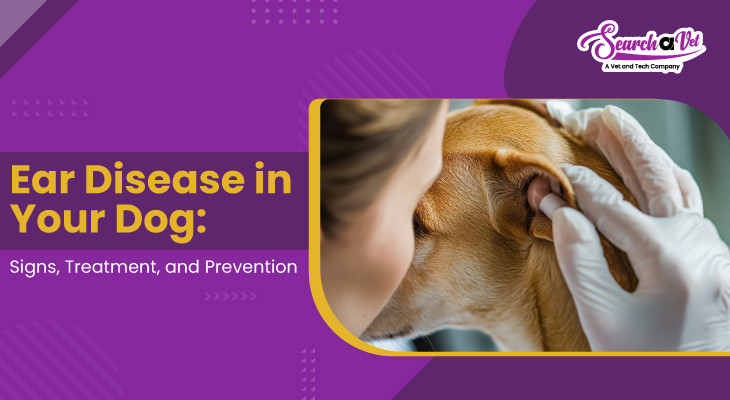5 Common Veterinary Ear Surgeries Every Pet Owner Should Know About
 Sep 19, 2024
Sep 19, 2024

Having a pet is the most beautiful experience one has ever had; however, caring for them requires special care, and monitoring their optimal health is extra challenging.
Similar to people, pets experience medical problems that may necessitate veterinary surgical interventions.
In the case of ear issues in animals and birds, specific circumstances may require veterinary ear surgery to relieve discomfort and avoid additional difficulties.
This article will explore 5 common animal ear surgeries that all pet owners should know about to better understand their pets' health requirements.
Let’s get started!
Aural Hematoma Ear Surgery (Providing Relief from Swollen Ears):
Aural hematoma is a swelling formed by blood that accumulates under the skin and cartilage of a pet's ear flap.
This condition is commonly observed when an animal vigorously scratches or shakes its head due to an underlying inflammation of the ear or an infection.
It can result in huge discomfort and distress to the pet and this leads to Aural Hematoma surgery.
During the procedure, the veterinarian:
- Makes an incision in the ear
- Drains the accumulated blood
- Sutures the ear to prevent further fluid buildup
Besides relieving pain, this surgery also involves reconstruction of the external contour of the ear and prevention of scar tissue formation.
Ear Canal Tumor Removal Surgery: Battling Ear Canal Tumors for a Better Quality of Life
Ear canal tumors, although relatively rare, can affect pets - particularly older dogs.
These tumors can lead to symptoms such as:
- Ear pain
- Discharge
- Hearing loss
Ear canal tumor removal surgery involves the meticulous removal (excision) of the tumor with surrounding healthy tissue to ensure complete eradication.
The extent of the surgery depends on the tumor's traits. In some cases, only a portion of the ear canal may need removal. However, for larger or more aggressive tumors, complete ear canal removal might be necessary.
While the surgery may seem significant, early detection and prompt surgical intervention significantly improve the chances of a successful outcome, including complete tumor removal and maximizing hearing preservation.
Lateral Ear Canal Resection: Addressing Chronic Ear Infections
Chronic ear infections are a persistent issue for some pets, especially those with long, floppy ears that can trap moisture and debris.
When traditional treatment options fail to provide relief, Lateral Ear Canal Resection might be recommended.
This surgery involves removing a portion of the external ear canal for:
- Improved ventilation
- Decreased likelihood of future infections
This veterinary ear surgery prevents recurrent infections and provides much-needed relief to pets suffering from prolonged discomfort.
Total Ear Canal Ablation: A Solution for Severe Ear Canal Issues
There are times when the ear infection or other conditions that affect a pet's ear canal become very severe and cannot be controlled or managed; then there is Total Ear Canal Ablation.
This surgical procedure requires the ligation of the ear canal and sometimes the obliteration of the middle ear structures.
Although this may sound rather drastic, Total Ear Canal Ablation is usually the final alternative in instances where the pet suffers from pain/discomfort or chronic septic infections of the ear canal.
After the procedure, pets may experience relief from their long-standing issues, even if it means sacrificing their hearing ability.
Bulla Osteotomy Surgical Procedure: Veterinary Ear Surgery to Relieve Deep Issues
The term "Bulla" refers to a bony structure within the middle ear, and Osteotomy involves the surgical cutting of bone.
When it comes to addressing complex and deep-seated ear problems in pets, the Bulla Osteotomy surgical procedure might be the perfect option.
This veterinary ear surgery is ideal for treating conditions that affect the middle and inner ear, such as chronic otitis media (middle ear infection) or growths and polyps.
During Bulla Osteotomy, the veterinarian:
- Creates an incision behind the affected ear
- Carefully removes a portion of the skull bone to access the bulla
This specialized procedure provides direct access to the middle ear, allowing the veterinarian to:
- Thoroughly clean the infected area
- Remove any diseased tissue
- Address any growths or infections that may cause pain and discomfort for the pet
The final steps include scraping the surface of the bone, replacing it with the correct position, and fixing it onto the original site.
Bulla Osteotomy is quite an extensive surgery, but it is also quite effective when traditional methods fail to be fully helpful.
Important to Note!
Like any other surgery, adequate preparations, professional skills, and strict adherence to postoperative procedures are crucial.
If you have a dog or cat that is experiencing some form of ear infection, whether major or minor or constant deep-seated ear issues, it would be wise to discuss this with your vet.
There is a greater chance that your pet needs the veterinary ear surgery mentioned above.
Wrapping Up!
Although ear problems are common in pets, veterinary surgical procedures can effectively address these complications and help ensure good health for our furry friends.
Timely interventions are important for alleviating discomfort, preventing complications, and improving your pet's overall quality of life.
If you suspect your pet is experiencing ear-related problems, consult a veterinarian promptly. Thus, you can make an informed decision in case your canine fellow needs veterinary ear surgery.
Search a Vet connects pet owners with a nearby veterinary vet. Additionally, you can select from several veterinarians - tailored to your pet's health concerns.
FAQs
What Is the Recovery Time After Aural Hematoma Surgery?
Generally, after the Aural Hematoma Procedure, pets may need to wear a protective cone for about 10-14 days. Depending on their healing progress, pets can resume normal activities within a few weeks.
Is Total Ear Canal Ablation a Common Procedure?
No, it’s not a common procedure, but a last resort for severe ear issues. Total Ear Canal Ablation is recommended when chronic infections or other problems significantly affect a pet's quality of life.
Will My Pet Regain Normal Hearing After Bulla Osteotomy?
The extent of hearing recovery after bulla osteotomy can vary. The primary goal of the procedure is to address underlying ear issues and alleviate pain rather than restore hearing. While some hearing improvement might occur, complete restoration is not guaranteed.




